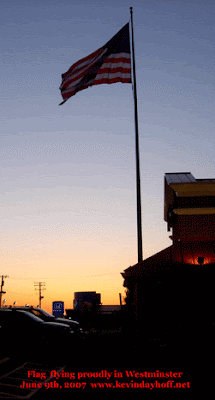
The long version of Sunday Carroll Eagle column for Sunday, June 8, 2008
by ©
Related: 20080606 Presidential Proclamation: Flag Day and National Flag Week

Tomorrow is the 231st birthday of the United States Flag. For the past 92 years we have observed June 14th as Flag Day.
Hopefully, you and your family will display the Old Glory for Flag Day.
Please take a moment to reflect upon the flag that has steadfastly stood for
The flag has remained a constant reminder of the sacrifices that have been made to maintain the freedoms, liberties, and way of life in this great experiment; we call the
When we display the flag, our community also expresses our gratitude to the men and women who have gone before and fought to ensure that the many blessings and freedoms we enjoy will continue for many generations to come.
Flag Day was established by President Woodrow Wilson on May 30, 1916. On August 3, 1949, President Harry Truman signed an Act of Congress that designated June 14 as National Flag Day.
Also this Saturday we celebrate the birthday of the United States Army. It was two years before the Flag Act of 1777; on June 14, 1775 that Congress established the United States Army. Ten companies of "expert riflemen" were originally authorized - approximately 800 soldiers.
On June 15, 1775, George Washington was chosen to head the Continental Army. The delegate to the Second Continental Congress who nominated George Washington was Thomas Johnson, from
While we are on the subject of birthdays, this year is also the occasion of another milestone in
The origins of the Army Reserve began in April 1908 with a group of doctors being designated as the Medical Reserve Corps, which could be called to active duty in an emergency. Today there are more than 200,000 “citizen-soldiers” in what we now know as the U.S. Army Reserve.
The origins of Flag Day go back to the Second Continental Congress, which met from May 10, 1775 to March 1, 1781. It passed the “Flag Act of 1777” on June 14, 1777.
Originally, the purpose of the Second Continental Congress was to hopefully continue negotiations with
Nevertheless, by the time the Second Continental Congress had convened in
Quickly, things weren’t not looking good for the home team. Instead of conducting economic negotiations with the most powerful nation on the planet at the time, the Second Continental Congress found itself at war; equipped with a non-existent army, no money, and the support of about one-third of the population, on a good day.
One of the immediate challenges for General Washington was to negotiate with a congressional committee in September 1775 for more soldiers, equipment, and supplies.
Factionalism plagued congress and regionalism challenged the military and the agreement reached with congress was ultimately not satisfactory.
According to Volume I of the U. S. Army’s “American Military History,” edited by Richard W. Stewart: “A Continental Army had been formed, but it fell far short of the goals Washington and Congress had set for it. This army was enlisted for but a year, and the whole troublesome process would have to be repeated at the end of 1776. The short term of enlistment was, of course, a cardinal error; but in 1775 everyone, including
A representative from

Tradition has it that a
Hopefully she got paid.
Congressman Hopkinson billed the “Board of Admiralty” in 1780 for his work on “‘the flag of the United States of America’ as well as several ornaments, devices, and checks appearing on bills of exchange, ship papers, the seals of the boards of Admiralty and Treasury, and the Great Seal of the United States. Hopkinson had received nothing for this work, and now he submitted a bill and asked "whether a Quarter Cask of the public wine" would not be a reasonable and proper reward for his labors.”
A congressional committee was appointed to investigate Congressman Hopkinson’s request for payment. It summoned witnesses and took testimony. However, “the men of the Board of Treasury ignored the summons. In its report to Congress, the committee recommended that the present board be dismissed.”

The more you read about the behavior of Congress in the early days of the Republic, the more one wonders if we were at war with Congress– or
On August 23rd, 1781, congress passed a resolution that the Congressman, a signer of the Declaration of Independence, be paid. Ultimately he was never paid, not because it was disputed that he did the work, but because his political adversaries prevailed in denying him payment.
Bear in mind, while all this is taking place - there is war going on; a war that never really went well.
Objective history that is ambivalent as to whether the American colonies won the war or
It was around August 23, 1781 that French Admiral de Grasse arrived from the Caribbean, blockaded the Chesapeake Bay, and pinned British General Cornwallis down at
Only by the Grace of God did our nation survive, in spite of ourselves – in spite of Congress.
When he is not preoccupied with reading Revolutionary War trivia,

No comments:
Post a Comment
Note: Only a member of this blog may post a comment.